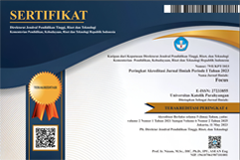The Role of Reading the Al-Quran on Peace of Mind
DOI:
https://doi.org/10.26593/focus.v4i1.6487Keywords:
Al-Qur’an, Soul, Students’ activities, Textual recitation, SpiritualityAbstract
Al-Qur’an is the guideline for human life, the holy book that there is no doubt in it, and even the medicine for all heart ailments. But sometimes, reading al-Qur’an becomes boring and does not necessarily have promising implications. This study aims to determine the role of reading al-Qur’an on the peace of mind of male students at the modern Islamic boarding school Al-Ihsan Baleendah, Bandung. The method used in this study is a qualitative descriptive method with a case study approach. Data collection techniques using observation and interviews. The subjects of this study were five people from a population of 12 who attended the congregation of reciting Qur’an (Jamiatul Qura—JMQ) at the Al-Ihsan Baleendah Modern Islamic Boarding School, Bandung. The sampling technique used is students. After the data is collected, the researchers use a qualitative descriptive analysis technique. The results showed that the mental condition of the male students who participated in the JMQ was calm and serene. The method of reading al-Qur’an is to follow adab ahlaqiyah and inner heart. Reading al-Qur’an and following the Shari'a recommended by religion. Reading al-Qur’an significantly increases the peace of mind of male students who attend JMQ at the Al-Ihsan Baleendah Modern Islamic Boarding School, Bandung.
References
Afrizal, M. (2014). Pemikiran Para Filosof Muslim Tentang Jiwa. An-Nida’, 39(1), 1–17.
Aji, M. H., Hilmi, M. Z., & Rahman, M. T. (2021). The Living Qur’an as a Research Object and Methodology in the Qur’anic Studies. Jurnal Iman Dan Spiritualitas, 1(1), 78–84.
Al-Qardhawi, Y. (1999). Berinteraksi dengan al-Quran. Gema Insani Press.
Albar, D., Rahman, M. T., SAM, M. N. B., Munawwaroh, S. M., Wasehudin, W., & Budiana, Y. (2020). Penciptaan dan Pemeliharaan Alam dalam Perspektif Al-Qur’an. Prodi S2 Studi Agama-Agama UIN Sunan Gunung Djati Bandung.
Ali, M., & Asrori, M. (2004). Psikologi remaja. In Bumi Aksara.
Apriola, K., Yuliharti, Y., & Yanti, Y. (2021). Konsep Pemikiran Pendidikan Islam Masa Ibnu Taimiyah. Kutubkhanah, 20(1), 32–52.
Arianto, E. (2009). Ketenangan Jiwa. Pebruari.
Arif, K. M., Uyuni, B., & Oktapiani, M. (2022). The Relationship Between the Intensity of Reading the Qur’an on Learning Achievement. AL-ISHLAH: Jurnal Pendidikan, 14(3), 4481–4488.
Aslam, M. (2021). The Ethnomedicinal Effects of Plants and Herbs Mentioned in Holy Quran and Hadith. Journal of Islamic and Religious Studies, 6(2), 15–38.
Evazi, M., & Saeedi, H. (n.d.). The Synergistic Relationship between the Psychology of" Dhikr and Peace" and the Epistemological Approach of the Verses of the Holy Qur’an.
Fahmī, M. (1982). Penyesuaian diri: pengertian dan peranannya dalam kesehatan mental. Bulan Bintang.
Haq, M. Z., & Sen, H. (2021). Transforming Hate into Compassion as an Islamic Nonviolent Thought of Bediüzzaman Said Nursi. Wawasan: Jurnal Ilmiah Agama Dan Sosial Budaya, 6(1), 13–30. https://doi.org/10.15575/jw.v6i1.13159
Hurlock, E. B. (2002). Psikologi Perkembangan (Suatu Pendekatan Sepanjang Rentang Kehidupan) (R. M. Sijabat (ed.); Istiwidayanti & Soedjarwo (trans.)). Erlangga.
Jaafar, N., & Sipon, S. (2022). Tadabbur al-Quran and its Implications for Mental and Emotional Well-Being under Movement Control Order Conditions. Revelation and Science.
Nevid, J. S., Rathus, S. A., & Greene, B. (2003). Psikologi Abnormal. Erlangga.
Nur, S. (2012). Energi Ilahi Tilawah. Republika.
Qureshi, N. A., Khalil, A. A., & Alsanad, S. M. (2020). Spiritual and religious healing practices: some reflections from Saudi National Center for Complementary and Alternative Medicine, Riyadh. Journal of Religion and Health. https://doi.org/10.1007/s10943-018-0677-0
Rahman, M. (2020). Filsafat Ilmu Pengetahuan. Prodi S2 Studi Agama-Agama UIN Sunan Gunung Djati Bandung.
Rofiqi, M. A., & Haq, M. Z. (2022). Islamic Approaches to Multicultural and Interfaith Dialogue. Integritas Terbuka: Peace and Interfaith Studies, 1(1), 47–58. https://doi.org/https://doi.org/10.59029/int.v1i1.5
Rusydati Khaerani, I. F. S., & Nurlaen, Y. (2019). Makna Simbolik Zikir Pada Jemaah Tarekat Qadiriyah Naqsabandiyah (Studi Kasus Pada Jemaah Tarekat Naqsabandiyah di Pondok Pesantren Sirnarasa Ciamis). Jurnal Studi Agama Dan Masyarakat, 15(2), 87–97. https://doi.org/10.23971/jsam.v15i2.1331
Salim, A. H. (2009). Menyembuhkan penyakit jiwa dan fisik. GIP.
Shihab, M. Q. (2008). Lentera Al-Quran: Kisah dan Hikmah Kehidupan. Mizan Pustaka.
Stanley, M. (2014). Qualitative descriptive: A very good place to start. In Qualitative research methodologies for occupational science and therapy (pp. 37–52). Routledge.
Taimiyyah, I. (1971). Muqaddimah fi Ushul al-Tafsir. Beirut: Dar Al-Qur’an Al-Karim.
Yuliani, F., Djamal, N. N., & Endi, E. (2019). Pengaruh kebiasaan Tadabbur Alquran terhadap kecerdasan spiritual anggota Komunitas Tadabbur Quran. Jurnal Psikologi Islam, 6(2), 37–50.

Downloads
Published
Issue
Section
License
Copyright (c) 2023 Khadher bin Ahmad, Dede Musa Samsul Huda

This work is licensed under a Creative Commons Attribution-ShareAlike 4.0 International License.



















